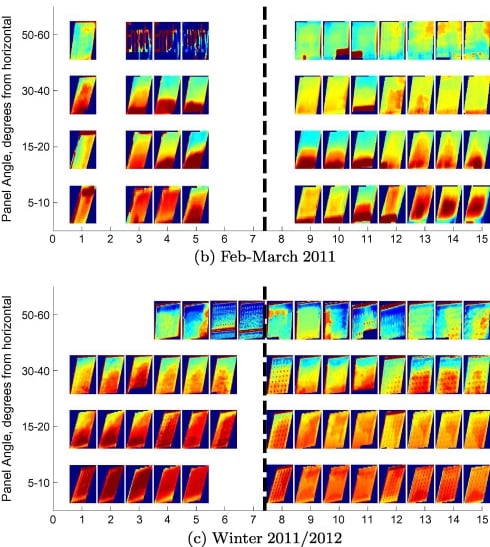Photovoltaic solar cell systems represent one of the most promising means of maintaining our energy intensive standards of living.[1] open access With Canada, and Ontario in particular, concentrating a much larger focus on photovoltaic development, there is a keen interest and concern in the effects of snow cover on solar energy yield. From small scale residential to large multi-MW ventures, developers are interested in the effect of snow on the performance of different types of panels and on the optimization of racking angles. There have been very few comprehensive studies performed which attempt to quantify the effects of snowfall, and none which provide universally applicable estimations of snow related losses. Thus, the first goal of this study is to attempt to gain a better understanding of the effects of snowfall on PV performance, and to provide some recommendations for reducing these losses.
In response to this, a project has been initiated to investigate the practical performance of commercial PV panels in the Ontario climate. As such a large outdoors test site is being commissioned as a collaboration between the Queen's Applied Sustainability Group (ASG) and St. Lawrence Sustainable Energy Applied Research Centre (SEARC) in order to provide highly accurate and practical data on PV performance year round. This site is being used in addition to the Queen's Innovation Park test site originally commissined by Queen's Applied Sustainability group and sponsored by Sustainable Energy Technologies Beyond providing practical information to industry and a test platform for advanced PV system design research the system will also be integrated into the curriculum of the ESAT program St.Lawrence College, helping to train the next generation of PV installers and developers.
The data collected from this project will lead the development of a model which will predict the annual losses due to snowfall for arrays set at a variety of angles. This information will allow developers to make more informed decisions when installing photovoltaic arrays in northern climates. In addition, testing capabilities being developed can be applied to future practical outdoors evaluations of panel performance.
Snowfall on PV Panels[edit | edit source]
In a global sense, the implementation of solar photovoltaics for grid-tied power generation applications is increasing at a rapid pace as recognition that this technology can provide an abundant and environmentally friendly energy source. At the moment the pattern of implementation of photovoltaics is governed in some part by government support offered by countries around the globe, at a variety of latitudes which are not necessarily the ideal equatorial regions where solar resource is maximized. As such, in 2010 74% of all installed PV resources were in countries which experience some amount of snowfall, with the top four countries for PV installations being Germany, Italy, USA, and Japan.
Studies[edit | edit source]
First results[edit | edit source]
- Heidari, N., Gwamuri, J., Townsend, T.,Pearce, J.M. (2015). Impact of Snow and Ground Interference on Photovoltaic Electric System Performance. IEEE Journal of Photovoltaics 5(6),1680-1685, (2015). doi: 10.1109/JPHOTOV.2015.2466448 open access
- Rob Andrews and Joshua M. Pearce, "Prediction of Energy Effects on Photovoltaic Systems due to Snowfall Events" in: 2012 38th IEEE Photovoltaic Specialists Conference (PVSC). Presented at the 2012 38th IEEE Photovoltaic Specialists Conference (PVSC), pp. 003386 –003391. Available: DOI open access
- Rob Andrews PhD Thesis https://qspace.library.queensu.ca/handle/1974/13112
The Effects of Snowfall on Solar Photovoltaic Performance[edit | edit source]
Source
- Rob W. Andrews, Andrew Pollard, Joshua M. Pearce, "The Effects of Snowfall on Solar Photovoltaic Performance ", Solar Energy 92, 8497 (2013). DOI: http://dx.doi.org/10.1016/j.solener.2013.02.014 open access
Abstract
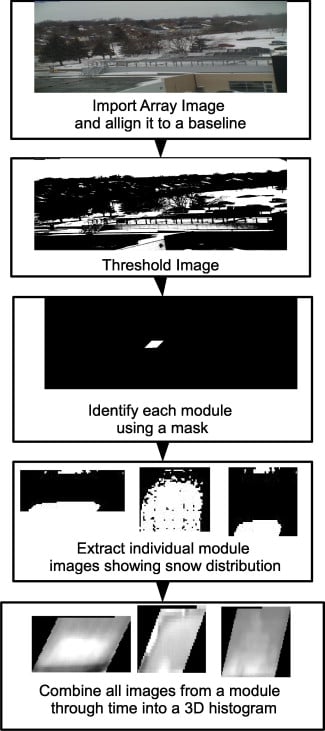
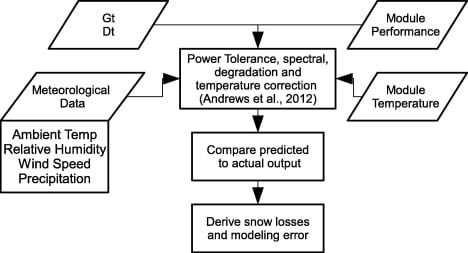
Solar photovoltaic (PV) systems are frequently installed in climates with significant snowfall. To better understand the effects of snowfall on the performance of PV systems, a multi-angle, multi-technology PV system was commissioned and monitored over two winters.
- A novel methodology was introduced and validated with this system, which allows for the determination of snowfall losses from time-series performance data with correlated meteorological observations down to a 5-min resolution.
- In addition, a new method for determining the probability distribution of snow deposition on a module from image data was developed.
It was found that the losses due to snowfall are dependent on the angle and technology being considered and the effects of increased albedo in the surroundings of a PV system can increase expected yields, particularly in the case of high tilt angle systems. Existing methods for predicting losses due to snowfall were investigated, and were found to provide overly conservative estimates of snow losses. Overall the results show that the proper assessment of snow related losses can help improve system performance and maintenance. It is concluded that proper characterization of the snowfall effect on PV system performance can influence better systems optimization for climates experiencing snowfall.
Previous Research[edit | edit source]
An Assessment of the TN Conseil Passive Melting Technology, Michael Ross, 1995[2][edit | edit source]
This report was compiled by Michael Ross, while working at Renewable Energy Research in Montreal, Quebec in 1995. It is a very comprehensive report which outlines a very detailed thermal model of a PV panel covered with snow. This report also summarizes very well the theory behind snow cover and provides an excellent review of snow properties as they relate to PV systems. It also includes the C++ code for a simulation program which attempts to predict panel temperatures as a function of time when covered with snow, and to use this information to determine the approximate times that a panel will remain covered with snow. Though this simulation provides an indication of the relative importance of a variety of factors on PV panel snow shedding, the actual accuracy of the model is poor. One issue with this model is its snow clearing assumption which states that when a panel reaches 0° it will clear itself, as water will have been formed. However, it is not apparent how much water must be melted to initiate sliding, and what effect angle has on this relationship.
An approach to the impact of snow on the yield of grid connected PV systems,[3][edit | edit source]
This report was compiled by the Bavarian Association for the Promotion of Solar Energy and is an analysis of snow losses on a 1MW roof mounted array in Germany at an incline of 28 degrees. The major findings from this report are that snow clearing can occur at panel temperatures as low as -10 degrees C, and that snow losses can range from 0.3% to 2.7% for this type of system, based on six years of data.
Snow-Covering Effects on Power Output from Photovoltaic Arrays[4][edit | edit source]
This study, performed in 1979 consists of a study has a method performed which is very similar to the current study investigation. Visual monitoring and pyranometer data were used to determine daily snow losses on a photovoltaic array angled at 30 and 40 degrees, the test apparatus is shown in Figure 4.
Unfortunately, due to data acquisition errors and the use of non-heated pyranometers, half of the data points were rejected making it very difficult to determine total yearly losses. The daily losses were calculated by comparing the measured PV output to the output from an ideal day, determined by multiplying the global irradiation by a factor (in this case 1/5.5) to find ideal PV output based upon data from snow-free PV responses. Using thse techniques, the yearly losses in 1979 for a 30 degree system were estimated at 2.0 % and for a 40 degree system were estimated as 0.84%, however there is a degree of uncertainty associated with this data set.
Queens Innovation Park system[edit | edit source]
A preliminary study has been performed in 2009-2010, funded by Sustainable Energy Technologies and located at Queen's Innovation Park, and consists of 16 panels mounted at angles from 0 to 70 degrees, with two each at increments of 10 degrees.
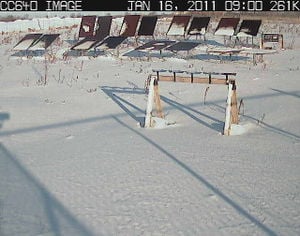
By monitoring panel output, solar influx, snow fall and meteorological factors a loss due to snowfall can be determined for a general system at a variety of angles. In addition, thermal panel measurements lead to a better understanding of snow shedding mechanisms. A series of analysis algorithms have been developed which allow for constant data mining to determine factors such as snow coverage ratio using image analysis, performance ratio, and estimated losses/gains due to snowfall. A detailed description of the sensors and measurements used in the study can be seen at Queen's Innovation Park Test Site.
Open Solar Outdoors Test Field[edit | edit source]
The SEARC Open Solar Outdoors Test Field consists of two discreet test beds, the largest of which is located on the roof of the new Wind Turbine and Trades building at St.Lawrence College and which has room for 60 commercial PV panels, which are divided between eight angles of 5.10,15,20,30,40,50 and 60 degrees.
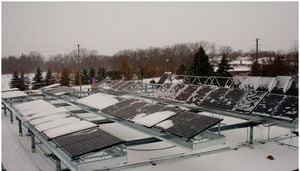
Live video for the test field is openly available online. The second test field is located on a flat rooftop at St.Lawrence College and consists of two commercial flat roof ballasted systems. Live video of this test field is also available online
Specifications[edit | edit source]
The SEARC outdoors test field is designed to be a state of the art outdoors test facility which makes this site one of the premier PV test beds in North America.The capabilities of this test bed are shown in the following table.
| Measurement | Device | Description | Accuracy |
| Solar Radiation-Direct | CMP-22 Pyranometer | The highest quality secondary standard device, calibration directly traceable to the World Radiometric Reference in Davos, Switzerland | <1% |
| Solar Radiation-Diffuse | CMP-22 Pyranometer | The highest quality secondary standard device, calibration directly traceable to the World Radiometric Reference in Davos, Switzerland, fitted with an adjustable shadow band | <1% |
| Solar Radiation-Albedo | CMP-11 Pyranometer | Secondary standard device, calibration directly traceable to the World Radiometric Reference in Davos, Switzerland. | <2% |
| Wind Speed and direction | RM-young wind monitor | WMO standard integrated wind speed and direction sensor. | +/- 3 m/s
+/- 3 ° |
| Temperature/RH | Rotronic HygroClip | Integrated temperature/ RH sensor with radiation shield. | RH: +/- 1.5%
Temp: +/- 0.2 C |
| Snow Depth | SR50 ultrasonic snow depth sensor | Provides accurate readings of snow on ground using calibrated ultrasonic pulses. Can give total snow depth and accumulation/settling rate. | +/- 0.4% |
| Data Acquisition System | Campbell Scientific CR1000 | The industry standard for high-accuracy environmental monitoring. Expanded with multiplexers to accept 106+ point measurements | +/- 0.12% |
| Photographs | StarDot NetCam IP camera | High resolution camera, photographing array at 5 minute intervals. Photos will be used with customized image analysis software to give: Covered area, accumulation rate, sliding rate. | 3 megapixel sensor |
| Panel Temperature | Custom T-type thermocouple | Monitoring of panel temperature profiles using Special Limits of Error T-type thermocouple wire. Attached to solid-state multiplexers with integrated cold-junction compensation. | +/- 0.5 C |
| Panel Power monitoring | Custom Transducers with MPPT | The panels are monitored using a proprietary DC power transducer, calibrated using instrumentation traceable to NIST. This transducer measures Vmp and Imp at the regular collection intervals. The use of a 99.7% efficient MPPT device ensures that the DC maximum power point of the panel under any real world condition is known | <1% |
| Spectral Distribution | AvaSpec-2048/3648 (200-1100nm) &AvaSpec-256-NIR2.5 (1000-2500nm) Spectrometer | High quality spectrometer allows for monitoring of spectral effects within the range of PV sensitivities. This can be extremely useful when monitoring practical performance ratios and when investigating the effects of Albedo on PV performance | >99.8 % corrected linearity, spectral range 200nm-2500nm |
Applications and Research Questions[edit | edit source]
The data collected from this apparatus will assist in determining the following parameters, which are essential to a proper PV system design
- How does cell shading in mono and poly crystalline silicon-based panels effect snow related losses? How does the spectral nature of diffuse and reflected light effect thin-film technologies?
- How does albedo effect PV performance and what is the best way to take advantage of these effects?
- What effect does the mounting arrangement have on losses? A low profile ballasted or a residential roof mount system provide additional obstacles to clearing, and may significantly increase snow related losses
- What other technologies and methods are available to clear the snow from a covered array, and are these economically viable when compared to the snow related losses of the system?
- How does uneven snow melt effect a string of modules? Are there possible improvements to string wiring or inverter performance which can better handle the uneven loads during snow shedding?
- What effect does the usage of hydrophobic and hydrophyllic coatings have on PV losses? Previous studies have shown that the use of these coatings can reduce the accretion of snow, and aid in the shedding of a collected snow mass. In addition a study performed at Queen's has shown that some of these coatings can increase the transmissivity of the glass encapsulant, increasing module efficiency even during the times where snowfall is not critical.
Expansion[edit | edit source]
This study offers a very detailed dataset for determining snow related losses for the two panels being utilized. However an expansion of this study would allow for a broader accumulation of datasets, and would result in a much more robust model. If you are interested, please contact Joshua Pearce.
In addition, though the first application of the SEARC Outdoors test field is to monitor the effects of snowfall on PV systems, this testing apparatus will be used in the future to perform technology comparisons and to expand knowledge in the field of practical PV system installation. We are always interested in expanding our base of research and if you are interested in collaboration, please contact Joshua Pearce or SEARC.
Related Pages[edit | edit source]
- Open Solar Outdoors Test Field
- Outdoor data acquisition
- Queen's Innovation Park Test Site
- Solar resource measurement for PV applications
- Snow Study Thesis outline
- Prediction of energy effects on photovoltaic systems due to snowfall events
- A new method to determine the effects of hydrodynamic surface coatings on the snow shedding effectiveness of solar photovoltaic modules
- Modeling of Snow-Covered Photovoltaic Modules [1]
- Sandia's PV and snow study [2]
- Performance of Bifacial Photovoltaic Modules on a Dual-Axis Tracker in a High-Latitude, High-Albedo Environment
- Differences in Snow Shedding in Photovoltaic Systems with Framed and Frameless Modules
In the News[edit | edit source]
- Overcoming solar panels winter problem - Toronto Star Feb 24, 2011
- Overcoming solar panels' winter blahs Toronto Star March 4, 2011
- Polar Solar -Txchnologist April 4, 2011
- Amping Up Solar in the Snowy North - MTU News 10-21-2013, CBS Detroit, WDIO ABC, Iron Mountain Daily News
- Researchers Study Performance of Solar Panels in Cold Climate - The Daily Fusion
- Researching Solar Panels and Snow - Get Solar
- Solar Researchers Dig Deeper Into Snow Issue - Earth Techling
- Snowy Solar - Solar International
- Michigan Tech tests if solar power works up North - Miami Herald via the Associated Press, Charlotte Observer, M Live, Seattle PI, Raliegh News Observer, UP Michigan/WDIO, ABC 12, Flint, Mining Journal, Mining Gazette, Fox Detroit, Houston Chronicle, The Republic (Indiana), KTVU San Francisco, Ludington Daily News, MI, Detroit News, Oakland Press, Michigan Radio (NPR), Grand Haven Tribune
- Are Solar Panels Usable in Snowy Climates? - AccuWeather, MSN, Fox News, Solar Magazine
- Snow-covered panels: Does solar power work in the Upper Peninsula? - UP Second Wave
- Are Solar Panels Usable in Snowy Climates? - Accuweather 2015
- Spending: Solar heats up - Chicago Tribune, Richmond Times Dispatch, Tulsa World
- How to design solar arrays in snowy areas - SolarDock Blog
- Is solar power still viable in winter? Facility Dude
- Solar Energy is a Go Even in the Snow - Solar Lender
- Snow and Solar Energy - Vancouver Renewable Energy
References[edit | edit source]
- ↑ J. M. Pearce, Photovoltaics - A Path to Sustainable Futures, Futures 34 (7), 663-674, 2002
- ↑ Ross, Michael M. D. Snow and Ice Accumulation on Photovoltaic Arrays: An Assessment of the TN Conseil Passive Melting Technology, Report # EDRL95-69(TR). Varennes, Québec, Canada: Natural Resources Canada CANMET Energy Diversification Research Laboratory, September 1995. (Technical Report)
- ↑ Becker, G., Schiebelsberger, B., Weber, W., Vodermayer, C., Zehner, M., & Kummerle, G. (2006). An Approach to the Impact of Snow on the Yield of Grid Connected PV Systems. Â
- ↑ Brench, B. L. (1979, December). Snow-covering effects on the power output of solar photovoltaic arrays. Retrieved February 27, 2011, from http://adsabs.harvard.edu/abs/1979STIN...8111551B


